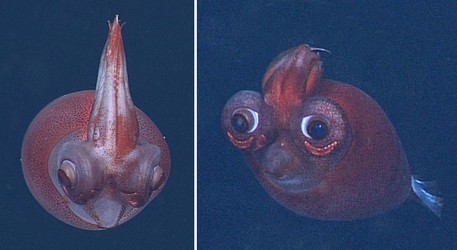Taonius borealis
Richard E. YoungIntroduction
Taonius borealis, known only from the temperate and boreal North Pacific, reaches a maximum size of 50 cm ML (Nesis, 1972).
Brief diagnosis:
A Taonius with ...
- Largest club sucker with one primary hook-like tooth and about 6-8 secondary hook-like teeth.
- Large club suckers of marginal series of manus not laterally compressed.
Characteristics
- Arms
- Arms short, about 1/4 of ML.
- Largest arm sucker-rings with low, truncated closely-set teeth on distal half or all around.
figure. Large arm suckers of T. borealis. Left - Distal-oral view of whole sucker (sucker 11 of arm II, 240 mm ML). Middle - Oral view of inner ring of same sucker. Right - Oral view of whole sucker (arm III, about 300 mm ML). Photographs by R. Young.
- Tentacles
- Largest two suckers of medial two series of club manus with one enlarged, hook-like tooth; 3-4 smaller secondary teeth present.
- Other enlarged suckers of medial series of club manus with two largest hook-like teeth more nearly equal in size; 6-8 (total) smaller secondary teeth present.
- Suckers of marginal series of manus circular (ie, not laterally compressed) with long, pointed teeth on distal and lateral margin of sucker ring.
- Tentacular stalk with two series of locking suckers on distal 2/3 to 3/4 of stalk. Distinct carpal cluster at base of manus with 6-7 smooth ringed suckers and matching knobs; knobs not always obvious.
- Head
- Occipital folds absent.
- Beaks: Descriptions can be found here: Lower beak; upper beak.
- Occipital folds absent.
- Mantle
- Skin dermis adjacent to the muscular mantle with alveolate structure (in large males only?).
- Skin dermis adjacent to the muscular mantle with alveolate structure (in large males only?).
- Fins
- Fins lanceolate, about twice as long as combined width; 1/3 of ML.
- Fins lanceolate, about twice as long as combined width; 1/3 of ML.
Comments
The following photographs provide a close-up view of the head and arms and show the arrangement of occular photophores and arm suckers.


Figure. Head and arms of T. borealis. Left - Ventral view. Right - Dorsal view. Note the orange photosensitive vesicles on the "brain" within the cephalic cartilage; the skin has been removed from this area. Photographs by Henk-Jan Hoving.
Life History
Paralarval stages of T. borealis are unknown. Below are photographs of T. borealis apparently in transition between paralarval and juvenile stages as indicated by the shape of the eyes.


Figure. Left - Ventral view of a young T. borealis. Right - Composite of three photographs of the same individual showing the shape of the eyes that appear to be in transition from an eliiptical to a tubular or to a hemispherical shape. © 2013 MBARI .
Behavior
Species of Taonius typically have eyes directed forward. However, they are quite capable of directing the eyes laterally as well as can be seen by the different eye orientations in the two insitu photographs below of a single T. borealis taken within seconds of each other.Distribution
Type locality: Western North Pacific at 44°7.8'N, 150°26.7'E. T. borealis is found the temperate and boreal North Pacific to as far south as Southern California in the Eastern North Pacific.References
Akimushkin, I.I. 1963. Cephalopods of the Seas of the U.S.S.R. Academy of Sciences of the U.S.S.R., Institute of Oceanology, Moscow, 235 pages. English translation: Israel Program for Scientific Translations, Jerusalem, 1965.
Nesis, K.N. 1972. A review of the squid genera Taonius and Belonella (Oegopsida, Cranchiidae). Zoologichesky Zhurnal, 51(3):341-350
Voss, N. A. 1980. A generic revision of the Cranchiidae (Cephalopoda; Oegopsida). Bull. Mar. Sci. 30: 365-412.
Title Illustrations

| Scientific Name | Taonius borealis |
|---|---|
| Location | N.W. Pacific off California at 34°25.79'N, 127°31.63'W |
| Acknowledgements | Taken by an ROV of the Monterey Bay Aquarium Research Institute. |
| Specimen Condition | Live Specimen |
| Life Cycle Stage | Subadult |
| View | Anterior |
| Copyright | © 2001 MBARI |
About This Page

University of Hawaii, Honolulu, HI, USA
Correspondence regarding this page should be directed to Richard E. Young at
Page copyright © 2015
 Page: Tree of Life
Taonius borealis .
Authored by
Richard E. Young.
The TEXT of this page is licensed under the
Creative Commons Attribution-NonCommercial License - Version 3.0. Note that images and other media
featured on this page are each governed by their own license, and they may or may not be available
for reuse. Click on an image or a media link to access the media data window, which provides the
relevant licensing information. For the general terms and conditions of ToL material reuse and
redistribution, please see the Tree of Life Copyright
Policies.
Page: Tree of Life
Taonius borealis .
Authored by
Richard E. Young.
The TEXT of this page is licensed under the
Creative Commons Attribution-NonCommercial License - Version 3.0. Note that images and other media
featured on this page are each governed by their own license, and they may or may not be available
for reuse. Click on an image or a media link to access the media data window, which provides the
relevant licensing information. For the general terms and conditions of ToL material reuse and
redistribution, please see the Tree of Life Copyright
Policies.
- First online 08 March 2011
- Content changed 11 October 2015
Citing this page:
Young, Richard E. 2015. Taonius borealis . Version 11 October 2015 (under construction). http://tolweb.org/Taonius_borealis/19610/2015.10.11 in The Tree of Life Web Project, http://tolweb.org/















 Go to quick links
Go to quick search
Go to navigation for this section of the ToL site
Go to detailed links for the ToL site
Go to quick links
Go to quick search
Go to navigation for this section of the ToL site
Go to detailed links for the ToL site